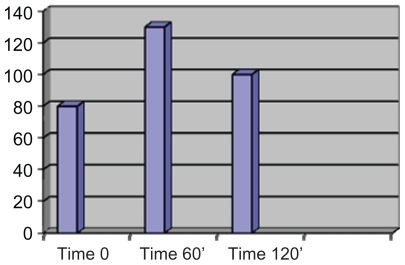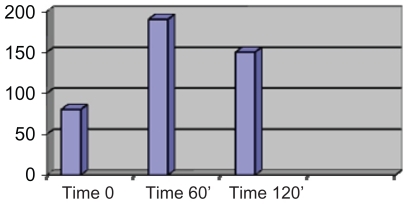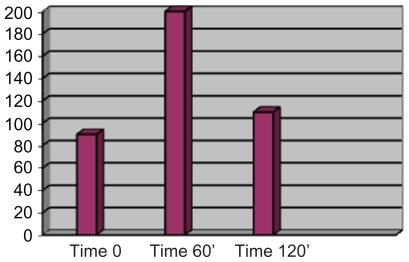Abstract
Recent observations suggest the presence of an interaction between leptin and the inflammatory system during bronchial asthma. Although there is evidence of a positive association between asthma and obesity in adults and children, little is yet known about the role of serum leptin, as a potential mediator for bronchial epithelial homeostasis, and intraleukocyte myeloperoxidase (MPO), a hemoprotein with a molecular weight of 140 kDa, expression of the inflammatory system, in asthmatic children. Glycemic tolerance is an important pathogenetic element in developing type 2 mellitus diabetes and a confirmed predictor of incident asthma-like symptoms in adults. This work is aimed at assessing a possible correlation between basal leukocyte myeloperoxidase levels, basal leptin and insulin-glycemic tolerance in obese children. Thirty obese children aged between 7 and 15 years were examined. The analyzed data showed a normal response to the insulinemic stimulus in children of both sexes whose basal leptin and MPO values, expressed as MPO intracellular index, were within the normal range.
Background
Recent observations suggest the presence of an interaction between leptin and the inflammatory system during bronchial asthma.Citation1,Citation2 Leptin, the hormone mainly synthesized by adipose tissue, is involved in a complex network of neurotrasmitters that modulate appetite. Many tissues produce leptin: the placenta syncytial trophoblast, the gastric fundus mucosa, skeletal muscle tissue and hypophysis. Most of leptin, however, is produced in adipose tissue. Leptin’s role is mainly to regulate food intake, but it also has a number of other metabolic functions: it stimulates macrophages and neutrophils, it has an antiapoptotic activity on various cell types, and it regulates T-cell proliferation. The production/suppression of leptin plasma levels is mainly related to the quantity of adipocytes, but also to various endocrinological factors, the main one being insulin levels. The lower the insulin levels, the lower the leptin synthesis. Low insulin levels are in fact typical indicators of hunger. Other factors that stimulate leptin secretion are: adrenergic stimuli, growth hormone (GH) and thyroid hormones such as triiodothyronine and inflammatory stimuli.
The leptin-producing obese (OB) gene is located on chromosome 7 and has three exons and two introns. The OB gene transcription can be regulated by response elements, such as sequences of nucleotides to which transcription factors bind (such as the cAMP Response Element [CRE]).Citation3–Citation5
Recent observations suggest the presence of an interaction between leptin and the inflammatory system. However, there is no adequate knowledge about the role of leptin in atopic states, such as bronchial asthma.Citation2 Although there is evidence of a positive association between asthma and obesity in adults and children, little is yet known about the role of leptin in asthmatic children: the findings suggest that leptin may play a role in atopic asthma, prevailing in postadolescent male children and in asthmatic boys. Insulin resistance (IR) is a confirmed predictor of incident asthma-like symptoms in adults and leptin is potentially a mediator for bronchial epithelial homeostasis: decreased expression of leptin/leptin receptor characterizes severe asthma and is associated with airway remodelling features.Citation6–Citation9
Myeloperoxidase (MPO) is a hemoprotein with a molecular weight of 140 kDa, and is made of two light subunits weighing 15 kDa. Each MPO molecule contains two porphyrins that play a fundamental role in the catalytic cycle. MPO is firstly found in the grains of neutrophils and eosinophils. It has a bactericidal potential since it catalyzes the production of hypochlorous acid, a potent oxidant generated by the reaction of chloride ion with hydrogen peroxide, which has a significant pro-inflammatory action and contributes directly to tissue damage. The expression of leptin receptors on eosinophils has recently shown that leptin can be considered a survival cytokine for human neutrophils and eosinophils and has a relevant potential role to play in allergic and inflammatory diseases.
Study aim
This work aims to verify through a retrospective study, the following personal observations: whether the relationship between obesity and asthma are mediated by an inflammatory state as measured by elevated leptin and leukocyte MPO levels in obese children, and by studying glycemic tolerance, which is an early sign of diabetes mellitus and associated IR.
Methods
Thirty obese children (15 males and 15 females with body mass index [BMI] > 30), without bronchial asthma symptoms, aged between 7 and 15 years were examined. Informed consent was obtained according to the criteria of the Helsinki Treaty.
Glucose tolerance in these patients was analyzed by providing them with a stimulus: they were administered 1.75 g of glucose/Kg and the response was assessed at times 0, 60, and 120 min. Leptin was evaluated using ELISA – Technogenetics (Milan, Italy). MPO of neutrophil and eosinophil counts were analyzed with ADVIA 120 automated analyzer as myeloperoxidase intracellular index (MPXI), a parameter derived from the mean position on the axis of an archetypal population of neutrophils and eosinophils: cells absorb light in proportion to the amount of colored peroxidase that is present (reported on x-axis) and spread light in proportion to their size (reported on y-axis). This whole blood automated method is certified and developed to assess eosinophil and neutrophil activity in terms of peroxidase content and cell morphology.
All subjects had an MPXI greater than −10 to ensure that no case of MPO deficiency was included.
The level of C-reactive protein (CRP) as an inflammation index was determined in all the patients and control tests on thyroid functionality, were performed by Modular P1 – Roche (Geneva, Switzerland) to exclude other simultaneous correlated pathologies ( and ). The BMI values for the children aged 7–15 years were 31.4 ± 2.7 kg/m?.
Table 1 Biochemical test values and MPXI values in normal response
Table 2 Biochemical test and MPXI values in pathological response
Results
The analyzed data showed a normal response to the insulinemic stimulus in children of both sexes whose basal leptin and MPXI values were within the normal range. ( and ). Pathological stimulus-related values were correlated to high basal leptin and MPXI levels ( and ). MPXI and leptin are directly correlated one with the other (P < 0.001). The CRP results and other main thyroid tests were in the normal range.
Discussion
MPXI for subjects of the same group of age, without asthma symptoms, but with obesity and normal range of basal glucose, are defined in the literature.Citation16,Citation17
Many evidences show a correlation between obesity and increased risk of bronchial asthma. Altered GT and IR are believed to play an significant role in asthma, although precise data are not available.Citation10–Citation15 IR is, after all, a common condition in many multifactorial diseases such as obesity and type 2 diabetes. The presence of a common inflammatory factor may explain the relationship between GT, IR, and asthma. Leptin is known to be one of these factors. A high MPXI could be another contributing factor that may have to be assessed when directly correlated with leptin. Our experience has shown that high MPO and leptin levels are indicative of an altered response to the glucose and IR load.
Our work is aimed at proposing the determination of leukocyte MPXI when analyzing basal leptin and serum glucose. This test is included in the hemochrome-cytometric exam and does not entail any extra costs. Associated high levels of MPXI and leptin in obese children may suggest an altered response to the oral glucose load and to be prediction of asthma.
Acknowledgment
The author expresses his thanks to Mrs Sarah Tripepi for her work. The author reports no conflicts of interest in this work.
References
- Bruno A Pace E Chanez P Leptin and receptor expression in asthma J Allergy Clin Immunol 2009 124 230 237 19539983
- Guler N Kirerleri E Ones U Leptin: does it have any role in childhood asthma? J Allergy Clin Immunol 2004 114 254 259 15316499
- Frühbeck G Gómez-Ambrosi J Muruzábal FJ Burrell MA The adipocyte: a model for integration of endocrine and metabolic signaling in energy metabolism regulation Am J Physiol Endocrinol Metab 2001 280 E827 847 11350765
- Fasshauer M Paschke R Regulation of adypocytokines and insulin resistance Diabetologia 2003 46 1594 1603 14605806
- Lyon CJ Law RE Hsueh WA Mini review: adiposity, inflammation, and atherogenesis Endocrinology 2003 144 2195 2200 12746274
- Gabriely I Barzilai N The role of fat cell derived peptides in age-related metabolic alterations Mech Ageing Dev 2001 122 1565 1576 11511397
- Zamboni M Zoico E Fantin F Relation between leptin and the metabolic syndrome in elderly women J Gerontol A Biol Sci Med Sci 2004 59 396 400 15071085
- Zoico E Di Francesco V Mazzali G Adipocytokines, fat distribution and insulin resistance in elderly men and women J Gerontol A Biol Sci Med Sci 2004 59 M935 939 15472159
- Armellini F Robbi R Zamboni M Resting metabolic rate, body-fat distribution and visceral fat in obese women Am J Clin Nutr 1992 56 981 987 1442666
- Zamboni M Armellini F Cominacini L Obesity and regional body-fat distribution in men: separate and joint relationships to glucose tolerance and plasma lipoproteins Am J Clin Nutr 1994 60 682 687 7942573
- Zamboni M Armellini F Harris T Effects of age on body fat distribution and cardiovascular risk factors in women Am J Clin Nutr 1997 66 111 115 9209177
- Lefebre AM Laville M Vega N Depot-specific differences in adipose tissue gene expression in lean and obese subjects Diabetes 1998 47 98 103 9421381
- Boden G Chen X Ruiz J Mechanisms of fatty acid-induced inhibition of glucose uptake J Clin Invest 1994 93 2438 2446 8200979
- Kern PA Saghizadeh M Ong JM The expression of tumor necrosis factor in human adipose tissue. Regulation by obesity, weight loss, and relationship to lipoprotein lipase J Clin Invest 1995 95 2111 2119 7738178
- Jequiér E Bjorntorp P Cairella M Howard AN Long-term measurement of energy expenditure in men: direct or indirect calorimetry? Recent Advances in Obesity Research III London, UK John Libbey and Company Publ 1981 130 135
- Leckie MJ Bryan SA Khan J Automated quantitation of circulating neutrophil and eosinophil activation in asthmatic patients Thorax 2000 55 471 477 10817795
- Fujisawa T Terada A Atsuta J Clinical utility of serum levels of eosinophil cationic protein (BCP) for monitoring and predicting clinical course in children asthma Clin Exp Allergy 1998 28 19 25 9537775
- Diez JJ Iglesias P The role of the novel adipocyte-derived hormone adiponectin in human disease Eur J Endocrinol 2003 148 293 300 12611609



